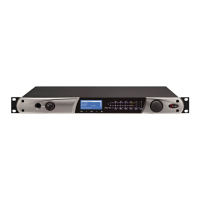Omnia.ONE SG
General Audio Specifications
Frequency Response: Complies with the standard 50 or 75 microsecond pre-emphasis curve within ± 0.50 dB, 30
Hz to 15 kHz. The analog left/right outputs and AES/EBU Digital outputs can be configured for flat or pre-
emphasized output.
System Distortion: Less than 0.01% THD, 20 Hz – 7.5 kHz. Second harmonic distortion above 7.5 kHz is not
audible in the FM system.
*Signal-Noise Ratio: > -80 dB de-emphasized, 20 Hz –- 15 kHz bandwidth, referenced to 100% modulation).
*The measured noise floor will depend upon the settings of the Input and Output Gain controls and is primarily governed
by dynamic range of the Crystal Semiconductor CS5361 A/D Converter which is specified as >110 dB. The dynamic range
of the internal digital signal processing chain is >144 dB.
Stereo Separation: Greater than 65 dB, 20 Hz –- 15 kHz; 70 dB typical..
Crosstalk: > -70 dB, 20 Hz -- 15 kHz.
Composite Outputs: Source Impedance: 5 ohms or 75 ohms, jumper-selectable. Single-ended
and floating over chassis ground.
Output Level: 0V to 10V in 0.05V steps, software adjustable.
D/A Conversion: Texas Instruments/Burr Brown PCM1798, 24-bit sigma-delta converter.
Configuration: Two electrically independent outputs. Software based level adjustment.
Load Impedance: 50 ohms or greater load is suggested.
Pilot Level: Adjustable from 4.0% to 12.0% in 0.1% steps and OFF.
Pilot Stability: 19 kHz, ± 0.5 Hz.
Signal-to-Noise Ratio: -85 dB typical, 75 μS de-emphasized, 15 kHz
bandwidth, referenced to 100% modulation).
Distortion: < 0.02% THD 20 Hz – 15 kHz bandwidth, 75 μS de-
emphasized, referenced to 100% modulation.
Stereo Separation: > 65 dB, 30 Hz – 15 kHz.
Linear Crosstalk: > -80 dB, main to sub or sub to main channel
(referenced to 100% modulation).
Non-linear Crosstalk: > -80 dB, main to sub or sub to main channel
(referenced to 100% modulation).
38 kHz Suppression: > 70 dB (referenced to 100% modulation).
76 kHz Suppression: > 80 dB (referenced to 100% modulation).
Pilot Protection: > -65 dB relative to 9% pilot injection, ± 1 kHz.
57 kHz (RDS/RBDS) Protection: better than -50 dB.
Connectors: Two EMI suppressed female BNC, floating over chassis ground.
Maximum Load Capacitance: 5nF (at 10 ohms source impedance).
Maximum cable length: 100 feet/30 meters RG-58A/U.
Analog Audio Input: Left/Right Stereo.
Electronically balanced.
Input impedance 10k ohms resistive.
Maximum Input Level: +22 dBu.
Nominal Input Level: +4dBu, which nets a -18dBFS input meter reading on a steady-
state signal when the Input Gain control is set to 0.0dB. Program material with a nominal
average level (VU reading) of +4dBu will typically produce peak readings on the input
meter in the range of -12 dBFS to -6dBFS. This is the correct operating level.

